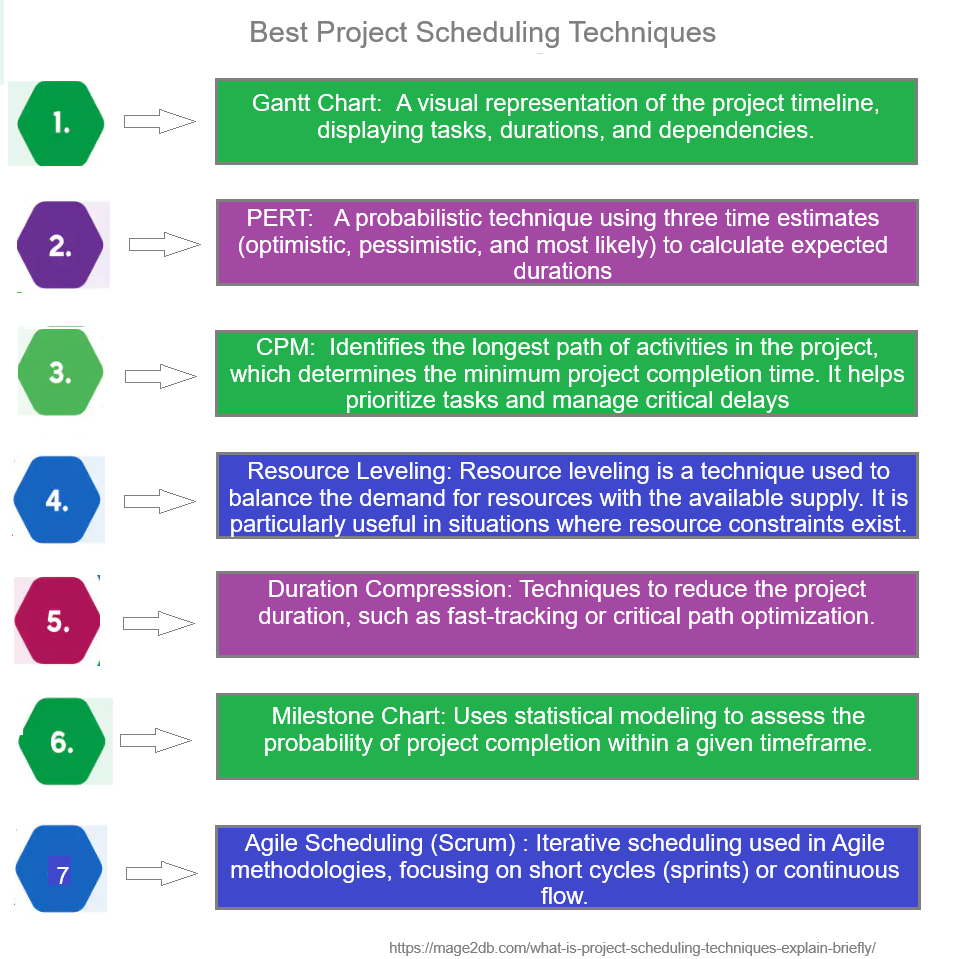
Project Scheduling Techniques:: These are methods used to plan, organize, and control tasks within a project to ensure timely completion. These techniques help project managers allocate resources efficiently, identify dependencies, and track progress.
The following below best Project Scheduling Techniques-
[1] – Gantt Chart: A visual representation of the project timeline, displaying tasks, durations, and dependencies. It helps visualize the project schedule and track progress.
Gantt Chart Features:
- Easy to read and understand.
- Shows overlapping tasks.
- Useful for tracking progress against the timeline.
[2] – Program Evaluation and Review Technique (PERT): A network-based method that uses probabilistic estimates for task durations, allowing for contingency planning.
Program Evaluation and Review Technique (PERT) Features:
- Uses three time estimates (optimistic, pessimistic, and most likely) to calculate an expected duration for each task.
- Focuses on time management rather than costs.
- Suitable for R&D projects where timelines can be unpredictable.
[3] – Critical Path Method (CPM): Identifies the longest path of activities in the project, which determines the minimum project completion time. It helps prioritize tasks and manage critical delays..
Critical Path Method (CPM) Features
- Identifies the longest stretch of dependent activities and measures the time required to complete them.
- Helps in determining the minimum completion time for the project.
- Critical tasks must be monitored closely as they affect the project completion date.
[4] – Resource Leveling: Resource leveling is a technique used to balance the demand for resources with the available supply. It is particularly useful in situations where resource constraints exist.
Resource Leveling Features:
Helps to minimize resource over-allocation.
Can extend the project duration to ensure resources are not overused.
Provides a more realistic timeline for project completion.
[5] – Duration Compression: Techniques to reduce the project duration, such as fast-tracking or critical path optimization.
[6] – Milestone Chart: Uses statistical modeling to assess the probability of project completion within a given timeframe.
Milestone Chart Features:
- Marks critical points like project start, phase completion, or product launch.
- Often used alongside Gantt charts for high-level tracking.
- Helps stakeholders focus on significant achievements.
[7] – Agile Scheduling (Scrum) : Iterative scheduling used in Agile methodologies, focusing on short cycles (sprints) or continuous flow.
Agile Scheduling (Scrum) Features:
Used in flexible, iterative projects (e.g., software development).
Work is divided into sprints (short cycles) with daily stand-up meetings.
Predictable Projects, (CPM or Gantt) works best.
While Uncertain Projects, (PERT/Agile) is better.
Choosing the right scheduling technique depends on:
✅ Project complexity
✅ Deadline constraints
✅ Resource availability
✅ Level of uncertainty
